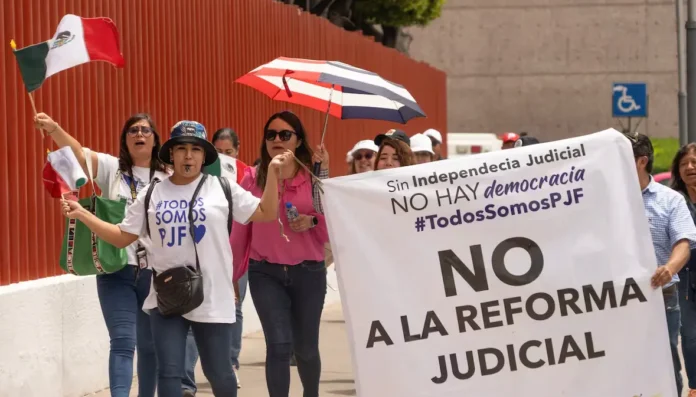
Around the world, judicial control is a core feature of the constitutional framework in electoral autocracies—those regimes that blend authoritarianism with democratic façades. Classical legal theory once cast the judiciary as a null power tasked only with upholding the Constitution. But democratic transitions have gradually strengthened the courts, turning them into a counterweight to majorities and a check on executives bent on consolidating power.
Today’s authoritarian leaders understand that judges can obstruct their plans to reshape political power. Control over the judiciary takes many forms: from electing judges by popular vote under the guise of “democratizing” justice, to appointing loyalists to key posts, or ousting judges deemed inconvenient.
But modern autocrats have also refined their methods. Institutional structures have been designed to discipline, monitor, and even remove judges who pose a threat to the regime. Whether through judicial disciplinary tribunals, conduct review chambers, or internal disciplinary boards, the goal remains the same: controlling the judiciary and undermining judicial independence. From Latin America to Eastern Europe and across parts of Asia, judges are subject to oversight by bodies that often function as instruments of political control.
On June 1, Mexico held its first-ever judicial elections. Among the new positions to be filled was the Judicial Disciplinary Tribunal, tasked with monitoring court rulings and judicial conduct. It’s worth noting that similar institutions have roots in electoral autocracies such as Poland, Hungary, and Russia, where judicial oversight is less about safeguarding independence and more about ensuring loyalty to ruling parties.
In Nicaragua, the Judicial Inspectorate and Disciplinary Commission oversee judicial behavior. But since 2006, the Ortega-Murillo regime has dismantled all checks and balances. At the end of 2024, all Supreme Court justices were removed, and in 2025, the National Assembly abolished judicial career paths. Positions are now held by regime loyalists, and these institutions serve more to instill fear than uphold independence.
In Eastern Europe, countries that once belonged to the Soviet bloc have abandoned liberal democracy. In Poland, President Andrzej Duda pushed through judicial reforms in 2017, creating a Disciplinary Chamber staffed by members of the ruling Law and Justice Party. The reform eliminated the last meaningful check on executive power.
In neighboring Hungary, Viktor Orbán launched a 2011 judicial reform meant to “clean house.” All sitting judges were removed, and a new Judicial Disciplinary Chamber was created to punish disobedient judges—reducing their salaries for resolutions that contravened the government’s will and undermining judicial autonomy and division of powers. Since 2022, the European Union has pressed for the restoration of judicial independence, but Orbán continues to resist external pressure.
In Turkey, the Council of Judges and Prosecutors holds the power to appoint and remove judges. Six of its thirteen members are chosen directly by the executive, and the rest by a parliament dominated by Erdogan. Since 2014, the council has been used to purge the judiciary of dissenting voices. Erdogan claims these moves combat corruption and improve judicial efficiency, aligning the courts with his vision for 21st-century Turkey.
Close by lies Vladimir Putin’s Russia—the model of modern autocracy. As with any strongman, the judiciary is under his control. Within the Russian Supreme Court sits a Disciplinary Chamber responsible for monitoring judges. It was created in 2008, as Putin tightened his grip on power. Like a modern-day czar, he ensures no court ruling contradicts his political project.
One telling example: in 2009, Supreme Court member Vladimir Yaroslavtsev gave an interview stating there was no judicial independence in Russia. During his tenure, he frequently voted against the pro-Putin majority. But in 2010, his colleagues accused him of undermining the court’s authority and forced his resignation—ending any remaining dissent.
Elsewhere in Asia, countries like Singapore have a Judicial Service Tribunal that oversees judicial discipline and removals. The city-state has been ruled by a hegemonic party since independence, and its senior judges tend to align with the government rather than assert judicial independence.
In Central Asia, countries like Kazakhstan, Uzbekistan, Kyrgyzstan, and Turkmenistan have disciplinary tribunals for judges—but these are anything but autonomous. After the Soviet Union’s collapse, authoritarian rulers took power. What changed was not the structure of governance, but the identities of those in control. Democratization and the creation of institutional checks never materialized.
Many countries have judicial oversight bodies that do not necessarily aim to improve accountability or efficiency, but rather to serve as tools of political domination—swords to prevent the separation of powers. The cases discussed above are examples of electoral autocracies, but other regimes prefer to exert direct executive control over the judiciary. This is the case in Venezuela, China, Cuba, North Korea, and Vietnam, among others.
*Machine translation, proofread by Ricardo Aceves.


